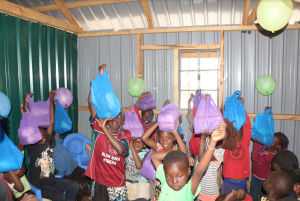Text by Victor Oduor
Growing up in the slum is a reality that many people face. No one chooses to be born in poverty or to have parents who struggle to provide for their basic needs. When you come from the slums, people often look down upon you as if you are to blame for your circumstances. This usually is a difficult situation for children, who may feel ashamed of their living conditions and majority of them try to hide this situation from their schoolmates. The reality of life in the slum is harsh, with limited access to clean water, toilets, and even food. While food may be relatively cheap in the slum, it is still a luxury for many families who struggle to afford even basic necessities, the only food we knew growing up was kales and ugali (corn starch)and if the diet changes that would be joy to the whole family. In the shanties, children struggle to get by as their parents may not always be able to provide for them the basic needs. In these situations, they may turn to their neighbors for help. While these neighbors may also be living in poverty, they are often willing to share what little they have to ensure that children have enough to eat ,this is the perfect description of it takes a whole village to raise a child
As children in the slums grow into teenager, they face new and more complex challenges. Hormonal changes and increased personal demands lead them to feel ashamed of asking for help or relying on their neighbors, even if those neighbors have always been there for them. These challenges can be difficult to navigate, and some teenagers turn to crime as a way to provide for themselves and their families. Girls in the slum are often vulnerable to exploitation, as most of them struggle to meet the demands of growing up. This has resulted in a larger number of them being taken advantage of by older boys who offer to provide for them in a small way. This has resulted in a high rate of school dropouts, a growing number of teenage mothers, high rate of abortion and crime in the slum.
The root causes of slum settlements are often complex, with factors such as population pressure in urban areas and a lack of government response to housing needs contributing to the problem. In order to survive in these difficult circumstances, many young people in the slum usually turn to gangs for protection of their dwelling places and to have a sense of belonging ,when this gangs become uncontrollable they usually start to extort money from individual houses with the reason that they are providing security . Unemployment and feelings of resentment towards those who seem to be doing better has also fueled crime in the slum. For those who are able to escape the cycle of poverty through education, the path is often difficult and requires a strong desire to succeed.
Growing up in a cramped and makeshift dwelling in the slum can make it difficult to find a quiet and peaceful place to study. Noise from neighbors and children playing outside can be distracting, and finding a space to focus on personal studies can be a challenge. Despite these difficulties, education has always been the only opportunity for children in the slum to improve their circumstances and achieve their goals as most of them have talents but due to our education system a lot of useful talents from slums go to waste . However, the path to education is not easy, as there are barriers such as school fees, uniforms, and a lack of support from parents who may not have had the opportunity to go to school themselves. It takes determination and perseverance to overcome these challenges and succeed in school.Majority of children in the slum rely on their peers or makeshift libraries to learn about the importance of education and to find ways to study and pass exams. Scholarships are the only way most of these children make it in education but it’s mostly available to those who excel academically, but these opportunities can be difficult to come by and often require a strong drive to succeed
Growing up in such conditions children usually lack access to social amenities or spaces to play, which lead them to interact with dangerous or unhealthy behaviours at a young age. One example of this is the drug trade, which may thrive in the slum due to high rates of unemployment and a lack of opportunities for young people. Children who learn about drugs at a young age may be more likely to turn to them as a coping mechanism when faced with disappointment or other challenges later in life. This always has a negative consequences such as depression and a downward spiral into drug addiction. It can be difficult for the government to combat these issues in the slum, where the narrow roads and haphazardly built houses create a conducive environment for illegal activities. It is sad to see friends from childhood fall into this trap, and it highlights the importance of addressing the root causes of crime in these communities which is access to equal opportunities like anybody else.
As a parent living in the slum, it can be difficult to protect your children from negative influences and to ensure that they grow up to be responsible and hardworking adults. Without access to social amenities and structured programs, children may be exposed to risky behaviors and may be more vulnerable to falling into crime. However, with the help of organizations and community resources, it is possible to support children in the slum and give them the skills and resources they need to succeed. Lack of opportunity and a desire to fit in with those who are more affluent can be major factors that drive young people to crime. Education is often the key to breaking this cycle and providing a better future for oneself, but without access to affordable and accessible education, some may feel that they have no other options. It is important to address the root causes of crime and to provide support and resources to those in need in order to create a safer and more equitable society









